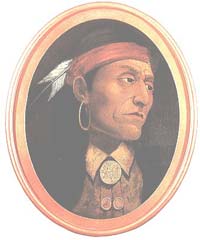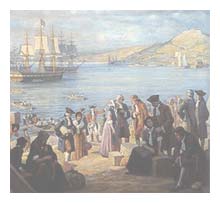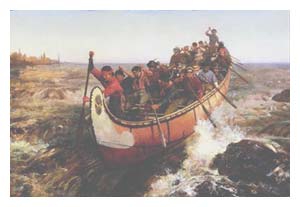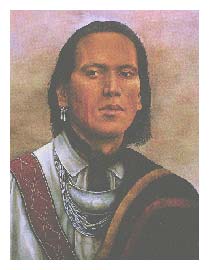 |
| History of Canada |
Early British Rule
The British faced two immediate problems in the vast territory
that had thus been added to their other Atlantic colonies. There
were more than 60,000 new French-speaking subjects in what had
formerly been New France. In addition, there were large tracts
of thinly settled wilderness in the Great Lakes area where their
little garrisons were seriously outnumbered by the Indians.

Odawa Chief, Pontiac |
Led by a clever and treacherous Ottawa chieftain named Pontiac,
the Indians suddenly rose against their new English masters
and overthrew these forts one by one, massacring the soldiers
in them without mercy. By the middle of 1763 the only British
soldiers left west of Lake Erie were in Fort Detroit. It alone
among the western forts held out against Pontiac until fresh
troops were rushed in, and the Indian uprising was subdued at
last.
The Quebec Act of 1774
Administration of the conquered province by a governor and an
appointed council was established by royal proclamation. In
1774 the English Parliament passed the Quebec Act. This was
the first important milestone in the constitutional history
of British Canada. Under its terms the boundaries of Quebec
were extended as far as the Ohio River valley. The Roman Catholic
church was recognized by the Quebec Act, and its right to collect
tithes was confirmed.
Also of enduring importance was the establishment of the French
civil law to govern the relations of Canadian subjects in their
business and other day-to-day relations with each other. British
criminal law was imposed in all matters having to do with public
law and order and offenses for which the punishment might be
fine, imprisonment, or in some cases death. These imaginative
gestures on the part of the English government won the admiration
of the religious leaders in Quebec and to a large extent the
goodwill of the people themselves. The privilege of an elected
assembly continued to be withheld, however.
The loyalty of the new province was soon put to the test. Within
a year of the passing of the Quebec Act, the rebelling 13 Atlantic
colonies sent two armies north to capture the "fourteenth colony."
Sir Guy Carleton, the British governor of Canada, narrowly escaped
capture when one of these armies, under Richard Montgomery,
took Montreal. Carleton reached Quebec in time to organize its
small garrison against the forces of Benedict Arnold. Arnold
began a siege of the fortress, in which he was soon joined by
Montgomery. In the midwinter fighting that followed, Montgomery
was killed and Arnold wounded. When spring came, the attacking
forces retreated. During the rest of the American Revolutionary
War, there was no further fighting on Canadian soil.
The United Empire Loyalists
When peace was established in 1783, many thousands of Loyalists,
who were referred to as Tories by their fellow countrymen, left
the newly created United States. They started their lives afresh
under the British flag in Nova Scotia and in the unsettled lands
above the St. Lawrence rapids and north of Lake Ontario. This
huge influx of settlers, who were known in Canada and England
as the United Empire Loyalists, marked the first major wave
of immigration by English-speaking settlers since the days of
New France.
Their arrival had two immediate consequences for the British
colonies. Both the Atlantic province of Nova Scotia and the
inland colony of Quebec had to be reorganized. The previously
unsettled forests to the west of the Bay of Fundy, once part
of French Acadia, had been included in Nova Scotia. In 1784
this area was established as a separate colony known as New
Brunswick. Cape Breton Island was simultaneously separated from
Nova Scotia (a division that was ended in 1820).

Arrival of the Loyalists |
In all, some 35,000 Loyalist immigrants are believed to have
settled in the Maritimes. The settlement of the more inaccessible
lands north and west of Lake Ontario and along the north shore
of the upper St. Lawrence proceeded somewhat more slowly. About
5,000 Loyalists came to this area. Upper and Lower Canada It
was clear that these United Empire Loyalists who had come to
the western wilderness of what was still part of Quebec would
not long be satisfied with the limited rights and French laws
established by the Quebec Act. Accordingly, in 1791 the British
Parliament enacted the Constitutional Act, whereby Quebec was
split into the two provinces of Upper and Lower Canada. Each
of these was to be governed by a legislative council appointed
for life and a legislative assembly elected by the people.
The right to be represented in a lawmaking assembly was something
new for the French-speaking inhabitants of the lower province.
Legislative assemblies had been in existence in Nova Scotia
since 1758, in Prince Edward Island since 1773, and in New Brunswick
since 1786. Representative government, however, was not responsible
government, as was to be demonstrated before another 50 years
had passed.
Upper and Lower Canada
It was clear that these United Empire Loyalists who had come
to the western wilderness of what was still part of Quebec would
not long be satisfied with the limited rights and French laws
established by the Quebec Act. Accordingly, in 1791 the British
Parliament enacted the Constitutional Act, whereby Quebec was
split into the two provinces of Upper and Lower Canada. Each
of these was to be governed by a legislative council appointed
for life and a legislative assembly elected by the people. The
right to be represented in a lawmaking assembly was something
new for the French-speaking inhabitants of the lower province.
Legislative assemblies had been in existence in Nova Scotia
since 1758, in Prince Edward Island since 1773, and in New Brunswick
since 1786. Representative government, however, was not responsible
government, as was to be demonstrated before another 50 years
had passed.
Settlement and Exploration
in the West
The Canadian prairies were not entirely unknown even in the
days of New France. As early as the 1730s a family of explorers
headed by Pierre Gaultier de Varennes, sieur de La Verendrye,
began a series of overland explorations far to the west of Lake
Superior. Their travels carried them into what is now the western
United States, perhaps as far as the foothills of the Rockies.
They visited Lake Winnipeg, the Red River, the Assiniboine River,
and the Saskatchewan River as far upstream as the fork formed
by the North and the South Saskatchewan. The posts of the Hudson's
Bay Company had given England a preferred jumping-off point
for exploration of the Canadian west. An expedition under Henry
Kelsey explored the territory between York Factory and northern
Saskatchewan in 1690, long before the journeys of the La Verendryes.
In 1754 Anthony Henday traveled from Hudson Bay as far as the
foothills of the Rockies, reaching a point near the site of
present-day Red Deer, Alta. Another Hudson's Bay Company trader,
Samuel Hearne, discovered Great Slave Lake in 1771, and by descending
the Coppermine River to its mouth, he became the first white
man to reach the Arctic Ocean by land. Although the Rockies
still barred the overland route to the western ocean, the Pacific
coast of Canada was visited by sea in 1778, when Capt. James
Cook explored the northwest coastline from Vancouver Island
to Alaska.

The Voyageurs |
In 1783 a group of Montreal merchants founded the powerful North
West Company. Not only did the new fur-trading company provide
sharp competition, but its trappers explored large parts of
the previously unknown expanses of the Canadian west. In 1789
Alexander Mackenzie (one of the Nor'westers) followed the river
which now bears his name from its source to the Arctic Ocean.
Disappointed because he had not discovered a route to the Pacific,
he set out on another expedition in 1792. After a strenuous
journey over the most rugged country on the continent, Mackenzie
and his companions at last crossed the Rocky Mountains to reach
the Fraser River in 1793. From the Fraser they portaged to the
Bella Coola, which they descended until they sighted the long-sought
western sea. Only a few weeks earlier Capt. George Vancouver
had explored the same part of the Pacific coast by sea. Mackenzie's
journey was the first made across the continent in either Canada
or the United States.
In 1808 the Fraser River was thoroughly explored by Simon Fraser,
after whom it is named. In 1811 David Thompson completed his
exploration of the Columbia from its source, in southeastern
British Columbia, to its mouth, in present-day Oregon.
The Selkirk Settlement
Although fur trading and settlement did not go well together,
Thomas Douglas, earl of Selkirk, became interested in the possibilities
of settling Scottish farmers who had lost their farms at home
in the fertile valley of the Red River near present-day Winnipeg.
From the Hudson's Bay Company he purchased a huge tract of 100,000
acres in this area.
In 1812 the first group of Selkirk's settlers from Scotland
and Ireland began to arrive from Hudson Bay, where they had
spent the previous winter. The jealousy of the Nor'westers,
as well as of the half-breeds, known as metis, was aroused immediately.
Fighting broke out between the new settlers and the established
traders. The colony was permanently established in 1817, when
Selkirk himself arrived with a force of military veterans to
put an end to the troubles and to punish the traders, whom he
held responsible for the bloodshed that had occurred. The North
West Company, a rival fur trading company, brought a lawsuit
against Selkirk for the action he had taken, and he was forced
to pay damages. Although Selkirk returned to Great Britain in
poor health in November 1818 and died a disappointed man a few
years later, he had begun the first permanent settlement on
the Canadian prairies.
The War of 1812
Meanwhile the British colonies far to the east found themselves
involved with the United States in a new war that threatened
to end their existence under the English flag.

Shawnee Chief, Tecumseh |
The declaration of war announced by the United States had several
causes. Chief among these was Britain's insistence on its right
to search American vessels for deserters from its own navy during
the war against Napoleon. In addition, England had interfered
with American trade with Europe. It was claimed too that the
British in Canada had been inciting the Indians against the
American settlements along the northwestern frontier. The early
hopes of the United States to drive the British entirely from
North America were dashed by a series of defeats at the hands
of British regulars and Canadian militia forces. Fort Michilimackinac,
at the entrance to Lake Michigan, was captured by the British
soon after the outbreak of fighting and was not recaptured during
the remainder of the war. An American attack across the Detroit
border was not only forced back but, under the brilliant generalship
of Gen. Isaac Brock, ably assisted by the Shawnee chieftain
Tecumseh and his warriors, was turned into a disastrous defeat.
The army defending Detroit was forced to surrender, and the
fort itself fell into British hands. Later the same year, the
United States launched an attack on the Niagara frontier. Brock
was killed early during the fighting at Queenston Heights, but
the invasion was repulsed.
Struggle for Self-Government
The successful defense of their homeland had not left the Canadians
incapable of seeing faults in their own form of government.
There were those--especially among the successful businessmen
and wealthier landowners--who believed that the colonists had
sufficient powers of self-government through their elected assemblies.
There were others, however, who saw little advantage in an assembly
whose bills could be defeated by the legislative council, or
could go unsigned by the governor on the advice of the executive
council. The real power did not lie in the hands of the people
through their elected representatives, but with appointed officials
who were responsible only to the government in Britain. In practice
the power lay in the hands of the governor and of his executive
advisers. The citizens could use their assembly as little more
than a forum in which to criticize the manner in which the government
was operated. Worse still, local matters that today are dealt
with by elected municipal bodies were all handled by the central
government of each colony.
Mackenzie and Papineau
Rebel
The period following the War of 1812 was one of expansion of
population, business, and settlement. This was especially true
in Upper Canada, where large numbers of newcomers were attracted
by low-cost land grants. The very growth of the colony offered
many opportunities for profit by those who could control the
land grants. One of the loudest accusers of the government's
administration of the land grants was William Lyon Mackenzie
(see Mackenzie, William Lyon). His criticisms centered on a
group that was known as the Family Compact. This was a loose
and somewhat misleading name for the members of the governing
class and their friends, among whom were actually many leaders
of great honesty and competence. Mackenzie, however, never clearly
understood the principles of responsible government by which
the executive would carry out the wishes of the government and
the government would hold office only so long as it had the
support of the people's elected representatives. Thus when the
government failed to redress the long series of grievances that
he listed, Mackenzie began to call for the independence of Upper
Canada. As affairs in Upper Canada moved toward a climax, an
equally serious crisis was building in Lower Canada. The grievances
were different, but the causes were similar. Here the real power
was in the hands of a British governor and his councilors, referred
to critically as the Chateau Clique, who constantly rebuffed
the elected representatives of the French-Canadian majority.
The leader of the radical reforms in Lower Canada was Louis
Joseph Papineau (see Papineau). Papineau, like Mackenzie, had
been several times elected to the provincial assembly. Like
Mackenzie, he had finally come to the conclusion that no lasting
reform could be achieved unless the bonds with Britain were
severed. Rioting occurred in Montreal in 1837. When the government
decided to arrest Papineau, he immediately fled across the border
to the United States. Largely because the radicals interpreted
this as persecution of their leader, open rebellion followed
in several centers. All revolts were quickly put down. Similar
troubles broke out in Upper Canada almost immediately. Mackenzie
prematurely called for an advance toward Toronto from his headquarters
just north of the city before his ill-equipped followers were
sufficiently well organized. The attack was driven back; and
the city, rapidly filling with Loyalist supporters, was fully
alerted. A few days later these forces marched northward against
Mackenzie and, after a short skirmish, dispersed his troops.
Like Papineau, Mackenzie fled across the United States border,
but he had not abandoned the struggle. Early in 1838 he took
possession of Navy Island in the Niagara River and, with a small
number of followers, tried to organize his planned republic
under what he spoke of as a "provisional government of Upper
Canada." The army and militia were now in full control of the
situation, and they forced Mackenzie to return to the United
States once again. Other disturbances followed along the border
during 1838. After a few unsuccessful raids, the United States
took steps to prevent its territory from being used for further
attacks against the Canadas. The struggle for reform was more
peaceful in the Maritimes. Here the leading reformers included
Joseph Howe, in Nova Scotia, and Lemuel Allan Wilmot, in New
Brunswick. Howe had a much clearer understanding of the principles
and advantages of responsible government than had either Mackenzie
or Papineau. Although he was persecuted for some of the criticisms
he voiced in his newspaper, the Novascotian, he rallied widespread
support. When sued for libel, he won his case.
The Durham Report
The seriousness of the troubles in British North America caused
deep concern in Great Britain, where memories of the American
Revolution could be recalled. At the request of Queen Victoria,
who came to the throne in 1837, John George Lambton, earl of
Durham, accepted appointment as governor in chief of British
North America with special powers as lord high commissioner.
He arrived in Quebec in the spring of 1838; though he ended
his stay before the year was out, his Report on the Affairs
of British North America is one of the most important documents
in the history of the British Empire. Durham recommended that
Upper and Lower Canada be united under a single parliament.
He said that if the colonies were given as much freedom to govern
themselves as the people of Great Britain, they would become
more loyal instead of less so. He even forecast the possibility
of a union some day of all the British colonies in North America.
His only serious error of judgment occurred when he said that
the French-speaking Canadians might be expected to be aborbed
by a growing English-speaking majority. Durham drove himself
and others tirelessly to gather the information he required
for his report during the few months he was in the country.
His political opponents at home, however, continued to attack
him, and, stung by their criticisms, he returned to England
to submit his findings. He did not live to witness the action
that was taken on his report, for within a year he became ill
and died.
Canada West and Canada
East
In 1840 the Act of Union was passed. It became effective the
next year and joined Upper and Lower Canada under a central
government. Henceforth the two colonies were to be known simply
as Canada West and Canada East, respectively. There was to be
an appointed upper chamber, or legislative council, in the new
government as well as an assembly composed of the same number
of elected members from each of the two old colonies. The seat
of government was established at Kingston; but after 1844 it
was moved to Montreal, then back and forth between Toronto and
Quebec, and finally to Ottawa in 1865. In the first several
years of this period, the principle of complete self-government
and the subordination of the governor's authority to that of
Parliament was developed and finally accepted. It was a critical
time in the constitutional history of Canada, and the ability
of the two chief Canadian nationality groups to get along with
each other was tested for many years. Each side produced great
public men. Prominent were Robert Baldwin from Canada West and
Louis Hippolyte Lafontaine from Canada East (see Baldwin, Robert).
Both men had taken part in the agitation preceding the rebellions
of 1837, but they had stood apart from the extreme measures
that led to armed insurrection. Both had grasped the meaning
of responsible government. By joining forces they formed a strong
coalition during the early years of the new government, and
the result was that much legislation was carried through. Included
were laws for establishing municipal governments, for founding
the University of Toronto as a nonsectarian institution, and
for changing the system of law courts. The real test of the
principle of responsible government took place in 1849. Parliament
passed the Rebellion Losses Bill, which had to go before the
governor-general, James Bruce, earl of Elgin, for his signature
to become law. The bill provided for compensation to those who
had suffered during the rebellion of 1837 in Lower Canada. It
was violently opposed by many of the Tories, who felt that tax
money was being turned over to former rebels. There was some
question as to whether or not Elgin would sign the bill as his
ministers advised him to do. When Elgin decided that he must
sign into law whatever bill was recommended to him by his Cabinet,
he was made the object of a torrent of abuse from the Tories.
Elgin's carriage was attacked, and his house was stoned. Furthermore,
rioting broke out, and the Parliament Buildings in Montreal
were razed by fire. Out of the ashes of the government buildings,
however, was born true colonial self-government that embodied
the principle of responsible cabinet rule.
The Colonies Grow Up
In the meantime Canada was swelling with settlers, and the foundations
of a British province on the west coast were being laid. A flood
of newcomers began to arrive after the War of 1812, mostly from
the British Isles. About 800,000 immigrants came to Canada between
1815 and 1850, sometimes spoken of as the period of the Great
Migration. The hardships faced by the new settlers were many.
The trials often began in the crowded, cholera-ridden, and poorly
provisioned sailing ships that brought the newcomers in vast
numbers across the Atlantic. The building of new settlements
went on in the Maritime Provinces and in the Canadas, and early
in the century Cape Breton Island was settled by Gaelic-speaking
farmers from the Scottish Highlands. The largest tracts of land
available for settlement were in Upper Canada, where the opening
of new subdivisions in the dense forests was an almost continuous
process during this whole period. One of the largest and most
famous of these was the huge tract of land on the north shore
of Lake Erie acquired by Thomas Talbot in about 1802. Established
in 1803, the Talbot Settlement was governed by him during the
whole period of its development, which covered almost 50 years.
In 1824 a large private enterprise known as the Canada Company,
promoted by John Galt, was launched with government backing.
Settlements began after the company obtained about 2.5 million
acres. Between 1824 and 1843 the company was responsible for
opening up most of the western part of the province lying north
of the Talbot country. Until the coming of the railway, the
principal method of moving heavy freight over long distances
was by water. Canals in the colonies were therefore improved,
and new ones were dug. Roads were cut through the bush to connect
the far-flung centers of settlement with lake and river ports.
On the backwoods farms great branding fires burned steadily
for weeks at a time as the pioneers slowly cleared their lands.
As a rule, the stumps were left in the ground to rot, which
required from five to six years for most woods. Cedar and pine
roots might hamper the use of horse-drawn plows for as long
as 15 to 20 years. In most respects pioneer life was very similar
in Canada and the United States.
|
|